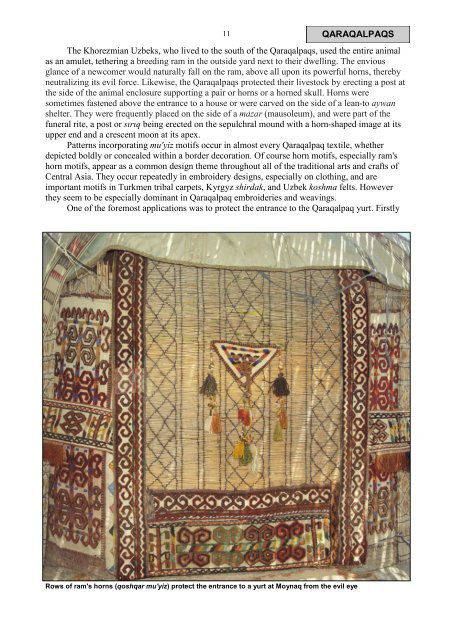QARAQALPAQS10Left: A ram’s skull wrapped in red broadcloth with button eyes protects the entrance to a home in Nobis.Centre: a sheep’s skull protects a yard at Bozataw. Right: Cattle skull protecting livestock at Qazayagh awil.particular item, activity, or craft. For example there were patron saints of agriculture, water,horses, weaving, jewellery making, and even yurt-making.One of the greatest dangers was the envious glance of the 'evil eye', the ko'z tiygiziw, whichcould give rise to numerous misfortunes. The evil eye was thought to be the cause of many of theillnesses suffered by people and their domestic animals – the result of a glance by a stranger or avisitor from another village. This led to many prohibitions. For example, strangers were forbiddento enter the cattle shed, walk into the herd, or even gaze at the cattle. In the event of misfortune, apiece of cloth was removed from the clothing of the culprit and was ignited so that the smoke couldbe used to fumigate the sickly animal.In difficult situations help was sought from a ta'wip, a local sorcerer who dispensed quackmedicine, or a porxan, a shaman who specialised in fortune-telling, predictions, and treatments,especially for female sterility. To treat an ailment the porxan organized a programme of daily zikirceremonies inside the yurt, in front of an audience of family and village members, all dressed intheir cleanest clothes. The 'patient' was 'treated' with wild leaping and howling to theaccompaniment of tambourines, followed by the reciting of incantations and spells and theperformance of rituals to drive away the evil spirits. This might involve beating the patient withthe carcass of a black crow, suspending the carcass of a steppe eagle from the yurt roof, or perhapsthe sacrificing of a ram or a cow and disposing of its bones (and hence the ailment). As we haveseen with our own eyes, some of the simpler quack 'treatments' are still used by some rural andurban Qaraqalpaqs today.Obviously prevention was always preferable to cure, so various measures were taken to protectpeople, property, and livestock from danger, especially those who were the most vulnerablesuch as infants, brides, and young animals. An armoury of devices were used to neutralize the evileye – the colour red, needles, shards of glass, the herb adıraspan (Syrian rue), triangles anddiamonds, and quotations from the Qu'ran. Readers should refer to <strong>OATG</strong> member Sheila Paine'sbook, Amulets, to comprehend the full gamut.One of the most common countermeasures used by the Qaraqalpaqs was to exploit the amuleticpower of livestock horns – usually ram's horns or bull's horns – either in the form of the hornsthemselves or depictions of horn-like motifs, both of which were referred to as mu'yiz.Goats and cattle were tough, the only domestic animals that could tolerate the mosquitoinfestedswamps of the Aral Delta, while rams and bulls were indomitable and fearless. In additionto power, each symbolized wealth and fertility. In the pre-Soviet era the entire wealth of aQaraqalpaq family of livestock-breeders was measured in terms of tuwar - literally cattle - so theconcepts of wealth, fertility, and protection were closely related. Goats and sheep were almostregarded as sacred animals.
11 QARAQALPAQSThe Khorezmian Uzbeks, who lived to the south of the Qaraqalpaqs, used the entire animalas an amulet, tethering a breeding ram in the outside yard next to their dwelling. The enviousglance of a newcomer would naturally fall on the ram, above all upon its powerful horns, therebyneutralizing its evil force. Likewise, the Qaraqalpaqs protected their livestock by erecting a post atthe side of the animal enclosure supporting a pair or horns or a horned skull. Horns weresometimes fastened above the entrance to a house or were carved on the side of a lean-to aywanshelter. They were frequently placed on the side of a mazar (mausoleum), and were part of thefuneral rite, a post or sιrιq being erected on the sepulchral mound with a horn-shaped image at itsupper end and a crescent moon at its apex.Patterns incorporating mu'yiz motifs occur in almost every Qaraqalpaq textile, whetherdepicted boldly or concealed within a border decoration. Of course horn motifs, especially ram'shorn motifs, appear as a common design theme throughout all of the traditional arts and crafts ofCentral Asia. They occur repeatedly in embroidery designs, especially on clothing, and areimportant motifs in Turkmen tribal carpets, Kyrgyz shirdak, and Uzbek koshma felts. Howeverthey seem to be especially dominant in Qaraqalpaq embroideries and weavings.One of the foremost applications was to protect the entrance to the Qaraqalpaq yurt. FirstlyRows of ram's horns (qoshqar mu'yiz) protect the entrance to a yurt at Moynaq from the evil eye
















